Accounting for R&D and Intangible Assets: AASB 138 Report
VerifiedAdded on 2022/12/15
|11
|2551
|237
Report
AI Summary
This report provides an executive summary and detailed analysis of accounting for intangible assets under AASB 138, focusing on a case study involving Technology Enterprises Ltd and its research and development project. The report discusses the appropriate accounting treatment for the project, the choice of accounting processes, and the application of AASB 138. It examines the valuation of intangible assets, including the use of historical costs versus fair market value, and addresses the impact of accounting practices on financial statement comparability. The report presents a response to the CEO's concerns, highlighting the importance of accurate financial reporting and the potential consequences of misrepresenting asset values. It concludes by emphasizing the significance of correct accounting practices for investor decisions and the company's overall financial health. The report covers topics such as asset valuation, impairment, and the impact of accounting standards on financial reporting and decision-making.

ACCOUNTING
2019
2019
Paraphrase This Document
Need a fresh take? Get an instant paraphrase of this document with our AI Paraphraser
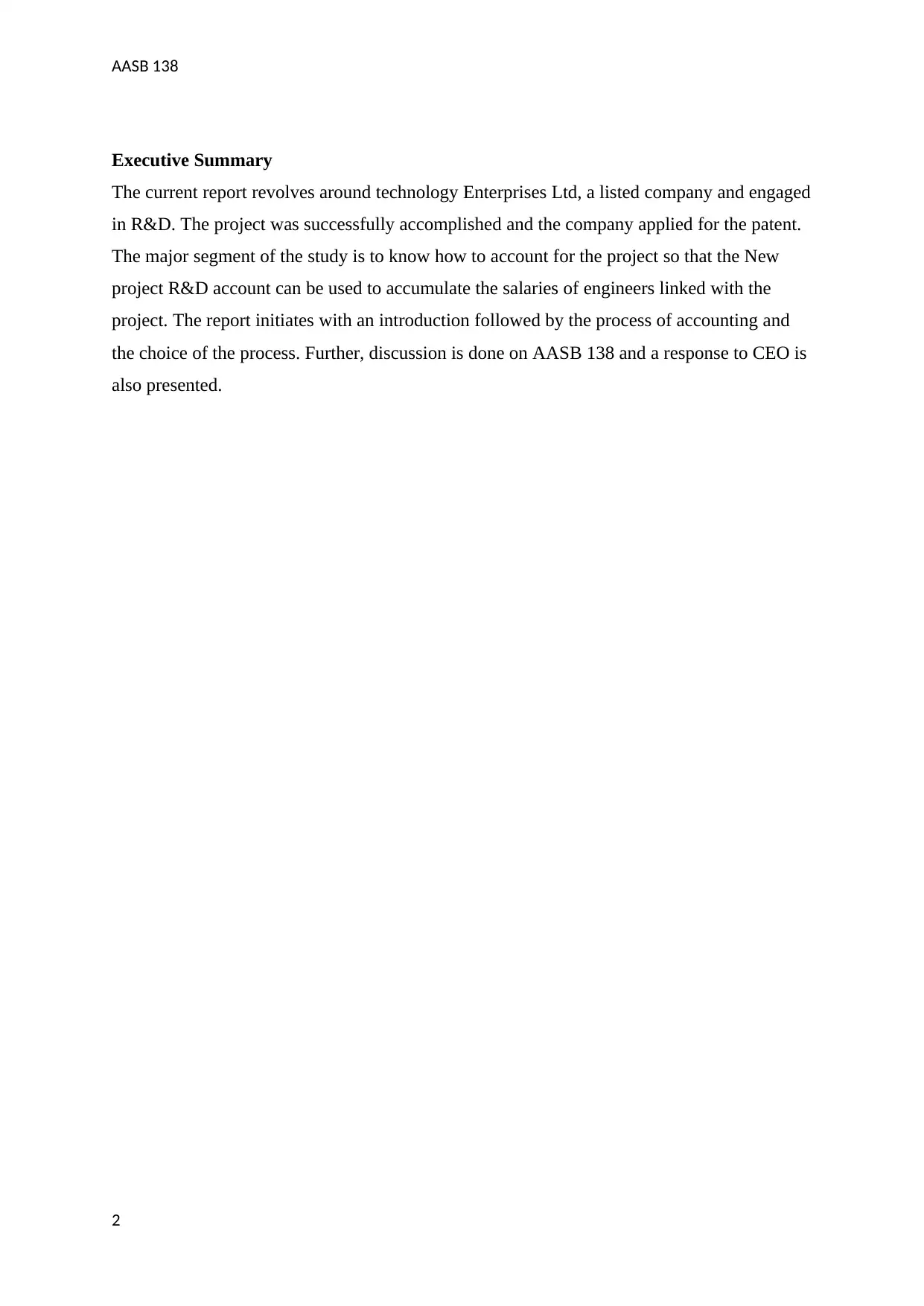
AASB 138
Executive Summary
The current report revolves around technology Enterprises Ltd, a listed company and engaged
in R&D. The project was successfully accomplished and the company applied for the patent.
The major segment of the study is to know how to account for the project so that the New
project R&D account can be used to accumulate the salaries of engineers linked with the
project. The report initiates with an introduction followed by the process of accounting and
the choice of the process. Further, discussion is done on AASB 138 and a response to CEO is
also presented.
2
Executive Summary
The current report revolves around technology Enterprises Ltd, a listed company and engaged
in R&D. The project was successfully accomplished and the company applied for the patent.
The major segment of the study is to know how to account for the project so that the New
project R&D account can be used to accumulate the salaries of engineers linked with the
project. The report initiates with an introduction followed by the process of accounting and
the choice of the process. Further, discussion is done on AASB 138 and a response to CEO is
also presented.
2
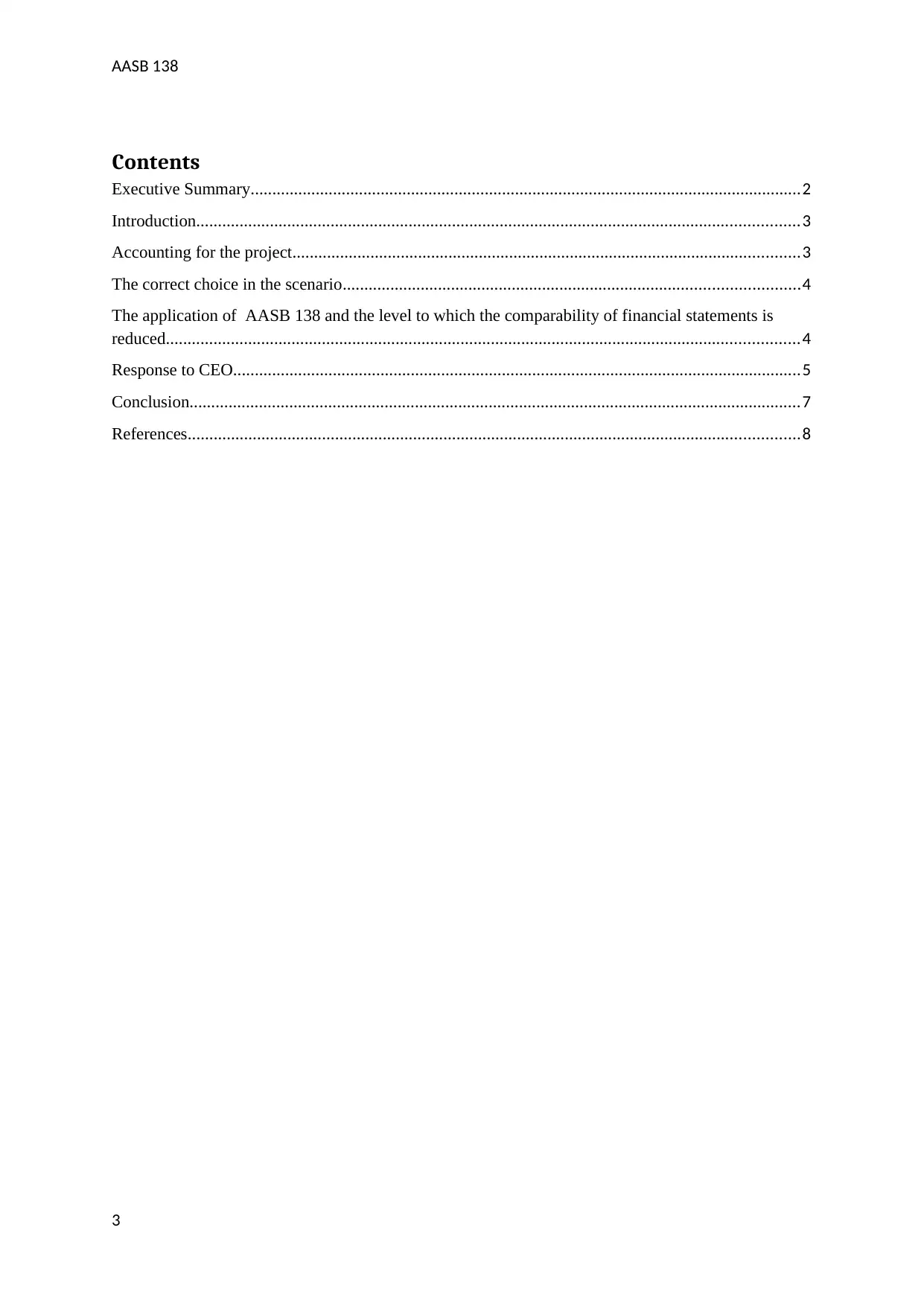
AASB 138
Contents
Executive Summary...............................................................................................................................2
Introduction...........................................................................................................................................3
Accounting for the project.....................................................................................................................3
The correct choice in the scenario.........................................................................................................4
The application of AASB 138 and the level to which the comparability of financial statements is
reduced..................................................................................................................................................4
Response to CEO...................................................................................................................................5
Conclusion.............................................................................................................................................7
References.............................................................................................................................................8
3
Contents
Executive Summary...............................................................................................................................2
Introduction...........................................................................................................................................3
Accounting for the project.....................................................................................................................3
The correct choice in the scenario.........................................................................................................4
The application of AASB 138 and the level to which the comparability of financial statements is
reduced..................................................................................................................................................4
Response to CEO...................................................................................................................................5
Conclusion.............................................................................................................................................7
References.............................................................................................................................................8
3
⊘ This is a preview!⊘
Do you want full access?
Subscribe today to unlock all pages.

Trusted by 1+ million students worldwide

AASB 138
Introduction
Assets can be defined as the resources owned by an organization that assists the same in
generating revenues and enhancing its financial statements. Assets can be segregated into two
categories based on its physical existence- tangible assets and intangible assets. Tangible
assets are the resources that can be seen, touched and felt such as equipments, land, plant and
machinery, etc while intangible assets are the type of assets that do not have a physical
existence that is these resources cannot be seen, touched or felt but still has a huge ability of
enhancing the functioning of an organization in multiple ways (Petty et. al, 2012). Goodwill,
trademarks, patents, intellectual property and other copyrights are examples of intangible
assets. It must be noted that intangible assets do not yield any benefits from the contractual
claims. Thus, assets hold huge significance in improving the financials of an organization and
help the same in enhancing its reputation in the industry.
Accounting for the project
If the intangible assets owned by an entity are capable enough of enhancing the profits for the
same, then only these shall be deemed as economically beneficial. The revenues generated as
a result of the intangible assets owned by an entity must be quantified in nature so that the
same can be recognized. There is also a need for intangible assets to undergo research and
development at regular intervals. It is very clearly mentioned in IAS 38, that the assets are
required to be valued at the cost of acquisition value only and therefore, this makes it
necessary for such costs that were incurred in the maintenance of intangible assets to be
added to the capital assets. Hence, the organization must refrain from using other value in the
valuation of its assets (Porter & Norton, 2014).
The methods used in evaluation processes differ from organization to organization. In order
to enhance the financial statements of an organization, the senior managers emphasize the
due focus on its assets by means of providing appropriate research and development at
regular intervals (Laux, 2014). The net worth of the intangible assets of the company was $1
million. It was noticed that the senior management of the company wanted to represent the
net worth of the intangible assets of the same to be 4 times greater than the actual value. The
accountant justified that the intangible assets of the company are measured at their historical
costs and are completely in sync with the accounting standards. As per AASB 138 and IAS
38, it is important for all the organizations to measure their intangible assets at their historical
4
Introduction
Assets can be defined as the resources owned by an organization that assists the same in
generating revenues and enhancing its financial statements. Assets can be segregated into two
categories based on its physical existence- tangible assets and intangible assets. Tangible
assets are the resources that can be seen, touched and felt such as equipments, land, plant and
machinery, etc while intangible assets are the type of assets that do not have a physical
existence that is these resources cannot be seen, touched or felt but still has a huge ability of
enhancing the functioning of an organization in multiple ways (Petty et. al, 2012). Goodwill,
trademarks, patents, intellectual property and other copyrights are examples of intangible
assets. It must be noted that intangible assets do not yield any benefits from the contractual
claims. Thus, assets hold huge significance in improving the financials of an organization and
help the same in enhancing its reputation in the industry.
Accounting for the project
If the intangible assets owned by an entity are capable enough of enhancing the profits for the
same, then only these shall be deemed as economically beneficial. The revenues generated as
a result of the intangible assets owned by an entity must be quantified in nature so that the
same can be recognized. There is also a need for intangible assets to undergo research and
development at regular intervals. It is very clearly mentioned in IAS 38, that the assets are
required to be valued at the cost of acquisition value only and therefore, this makes it
necessary for such costs that were incurred in the maintenance of intangible assets to be
added to the capital assets. Hence, the organization must refrain from using other value in the
valuation of its assets (Porter & Norton, 2014).
The methods used in evaluation processes differ from organization to organization. In order
to enhance the financial statements of an organization, the senior managers emphasize the
due focus on its assets by means of providing appropriate research and development at
regular intervals (Laux, 2014). The net worth of the intangible assets of the company was $1
million. It was noticed that the senior management of the company wanted to represent the
net worth of the intangible assets of the same to be 4 times greater than the actual value. The
accountant justified that the intangible assets of the company are measured at their historical
costs and are completely in sync with the accounting standards. As per AASB 138 and IAS
38, it is important for all the organizations to measure their intangible assets at their historical
4
Paraphrase This Document
Need a fresh take? Get an instant paraphrase of this document with our AI Paraphraser
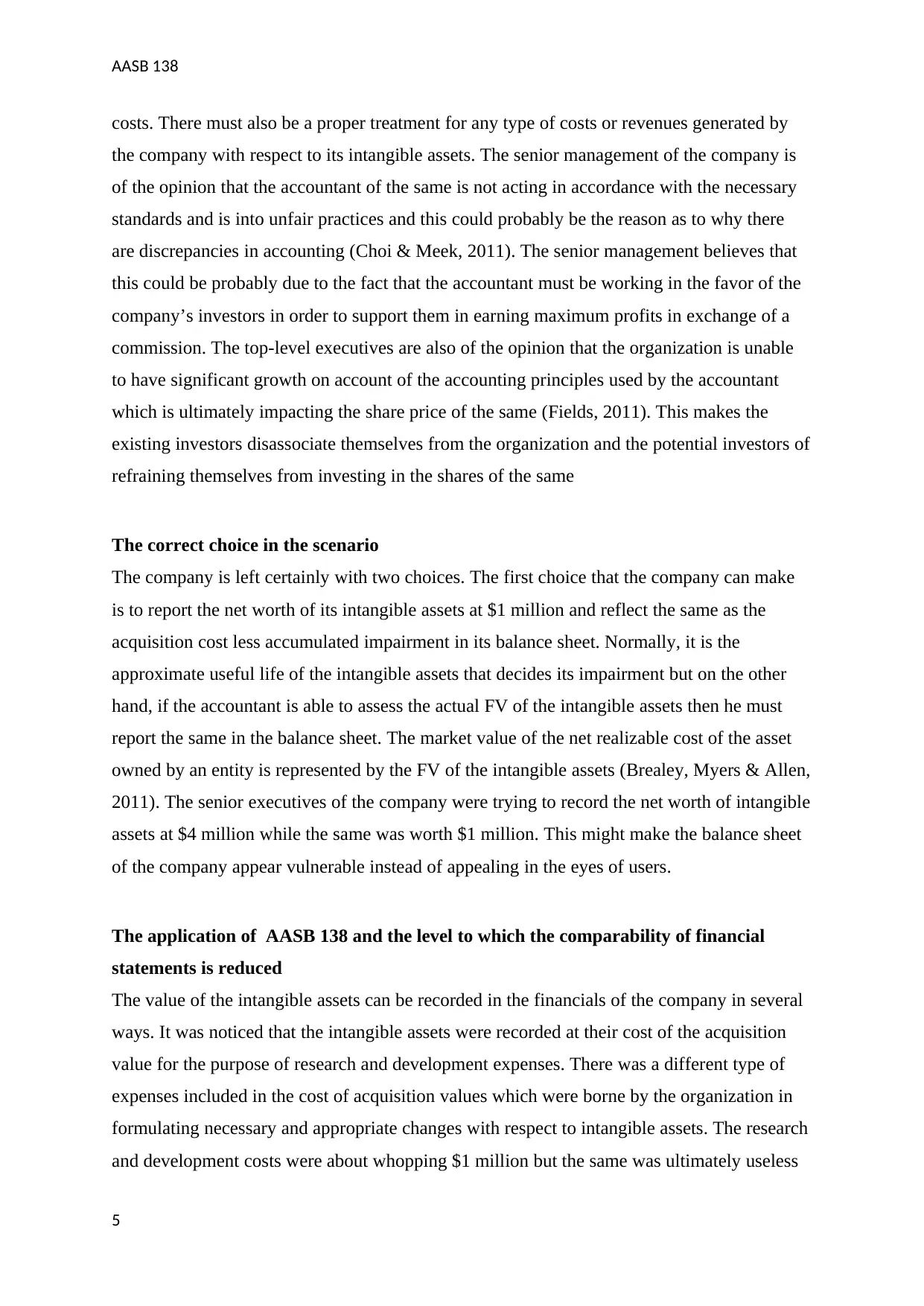
AASB 138
costs. There must also be a proper treatment for any type of costs or revenues generated by
the company with respect to its intangible assets. The senior management of the company is
of the opinion that the accountant of the same is not acting in accordance with the necessary
standards and is into unfair practices and this could probably be the reason as to why there
are discrepancies in accounting (Choi & Meek, 2011). The senior management believes that
this could be probably due to the fact that the accountant must be working in the favor of the
company’s investors in order to support them in earning maximum profits in exchange of a
commission. The top-level executives are also of the opinion that the organization is unable
to have significant growth on account of the accounting principles used by the accountant
which is ultimately impacting the share price of the same (Fields, 2011). This makes the
existing investors disassociate themselves from the organization and the potential investors of
refraining themselves from investing in the shares of the same
The correct choice in the scenario
The company is left certainly with two choices. The first choice that the company can make
is to report the net worth of its intangible assets at $1 million and reflect the same as the
acquisition cost less accumulated impairment in its balance sheet. Normally, it is the
approximate useful life of the intangible assets that decides its impairment but on the other
hand, if the accountant is able to assess the actual FV of the intangible assets then he must
report the same in the balance sheet. The market value of the net realizable cost of the asset
owned by an entity is represented by the FV of the intangible assets (Brealey, Myers & Allen,
2011). The senior executives of the company were trying to record the net worth of intangible
assets at $4 million while the same was worth $1 million. This might make the balance sheet
of the company appear vulnerable instead of appealing in the eyes of users.
The application of AASB 138 and the level to which the comparability of financial
statements is reduced
The value of the intangible assets can be recorded in the financials of the company in several
ways. It was noticed that the intangible assets were recorded at their cost of the acquisition
value for the purpose of research and development expenses. There was a different type of
expenses included in the cost of acquisition values which were borne by the organization in
formulating necessary and appropriate changes with respect to intangible assets. The research
and development costs were about whopping $1 million but the same was ultimately useless
5
costs. There must also be a proper treatment for any type of costs or revenues generated by
the company with respect to its intangible assets. The senior management of the company is
of the opinion that the accountant of the same is not acting in accordance with the necessary
standards and is into unfair practices and this could probably be the reason as to why there
are discrepancies in accounting (Choi & Meek, 2011). The senior management believes that
this could be probably due to the fact that the accountant must be working in the favor of the
company’s investors in order to support them in earning maximum profits in exchange of a
commission. The top-level executives are also of the opinion that the organization is unable
to have significant growth on account of the accounting principles used by the accountant
which is ultimately impacting the share price of the same (Fields, 2011). This makes the
existing investors disassociate themselves from the organization and the potential investors of
refraining themselves from investing in the shares of the same
The correct choice in the scenario
The company is left certainly with two choices. The first choice that the company can make
is to report the net worth of its intangible assets at $1 million and reflect the same as the
acquisition cost less accumulated impairment in its balance sheet. Normally, it is the
approximate useful life of the intangible assets that decides its impairment but on the other
hand, if the accountant is able to assess the actual FV of the intangible assets then he must
report the same in the balance sheet. The market value of the net realizable cost of the asset
owned by an entity is represented by the FV of the intangible assets (Brealey, Myers & Allen,
2011). The senior executives of the company were trying to record the net worth of intangible
assets at $4 million while the same was worth $1 million. This might make the balance sheet
of the company appear vulnerable instead of appealing in the eyes of users.
The application of AASB 138 and the level to which the comparability of financial
statements is reduced
The value of the intangible assets can be recorded in the financials of the company in several
ways. It was noticed that the intangible assets were recorded at their cost of the acquisition
value for the purpose of research and development expenses. There was a different type of
expenses included in the cost of acquisition values which were borne by the organization in
formulating necessary and appropriate changes with respect to intangible assets. The research
and development costs were about whopping $1 million but the same was ultimately useless
5
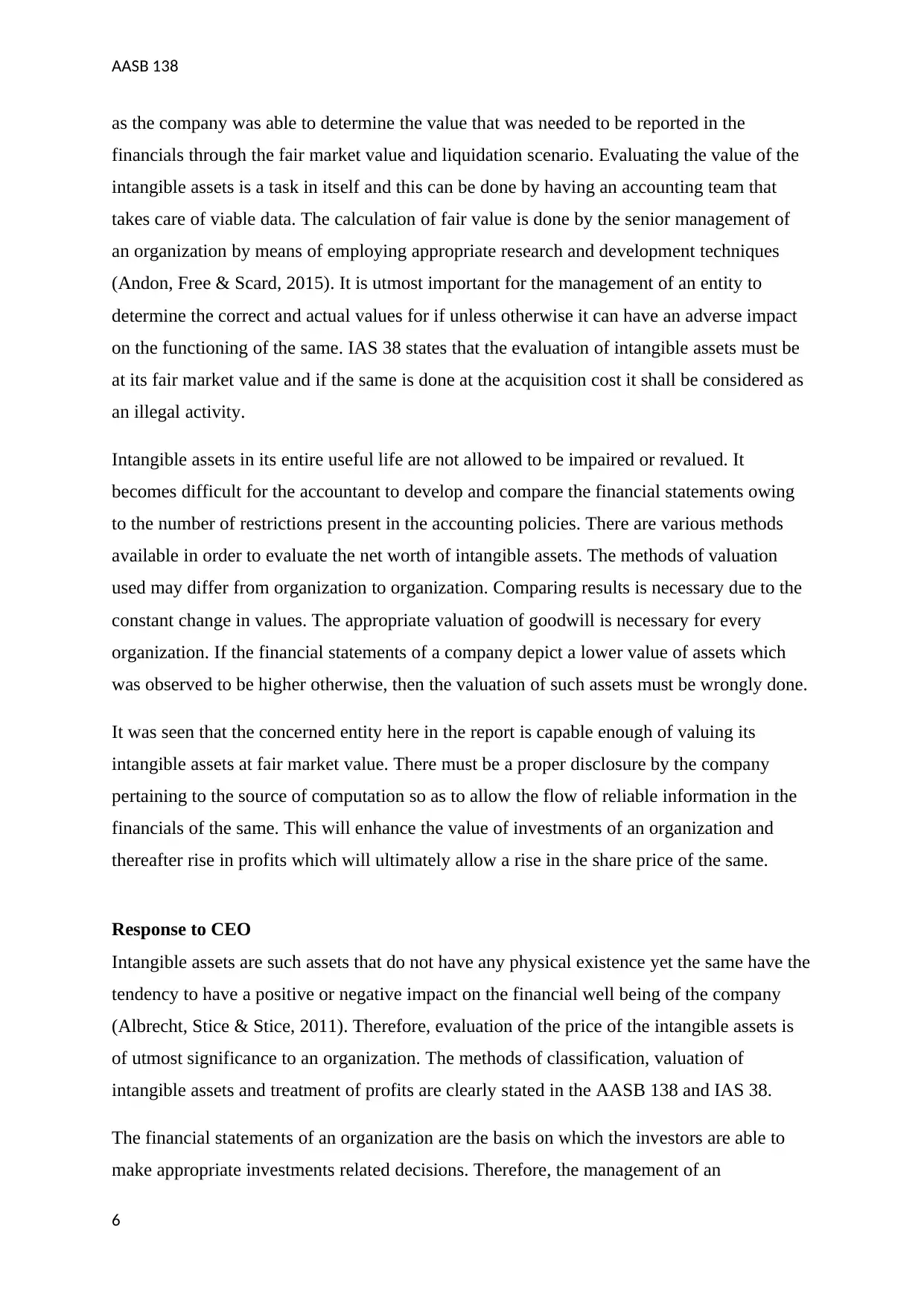
AASB 138
as the company was able to determine the value that was needed to be reported in the
financials through the fair market value and liquidation scenario. Evaluating the value of the
intangible assets is a task in itself and this can be done by having an accounting team that
takes care of viable data. The calculation of fair value is done by the senior management of
an organization by means of employing appropriate research and development techniques
(Andon, Free & Scard, 2015). It is utmost important for the management of an entity to
determine the correct and actual values for if unless otherwise it can have an adverse impact
on the functioning of the same. IAS 38 states that the evaluation of intangible assets must be
at its fair market value and if the same is done at the acquisition cost it shall be considered as
an illegal activity.
Intangible assets in its entire useful life are not allowed to be impaired or revalued. It
becomes difficult for the accountant to develop and compare the financial statements owing
to the number of restrictions present in the accounting policies. There are various methods
available in order to evaluate the net worth of intangible assets. The methods of valuation
used may differ from organization to organization. Comparing results is necessary due to the
constant change in values. The appropriate valuation of goodwill is necessary for every
organization. If the financial statements of a company depict a lower value of assets which
was observed to be higher otherwise, then the valuation of such assets must be wrongly done.
It was seen that the concerned entity here in the report is capable enough of valuing its
intangible assets at fair market value. There must be a proper disclosure by the company
pertaining to the source of computation so as to allow the flow of reliable information in the
financials of the same. This will enhance the value of investments of an organization and
thereafter rise in profits which will ultimately allow a rise in the share price of the same.
Response to CEO
Intangible assets are such assets that do not have any physical existence yet the same have the
tendency to have a positive or negative impact on the financial well being of the company
(Albrecht, Stice & Stice, 2011). Therefore, evaluation of the price of the intangible assets is
of utmost significance to an organization. The methods of classification, valuation of
intangible assets and treatment of profits are clearly stated in the AASB 138 and IAS 38.
The financial statements of an organization are the basis on which the investors are able to
make appropriate investments related decisions. Therefore, the management of an
6
as the company was able to determine the value that was needed to be reported in the
financials through the fair market value and liquidation scenario. Evaluating the value of the
intangible assets is a task in itself and this can be done by having an accounting team that
takes care of viable data. The calculation of fair value is done by the senior management of
an organization by means of employing appropriate research and development techniques
(Andon, Free & Scard, 2015). It is utmost important for the management of an entity to
determine the correct and actual values for if unless otherwise it can have an adverse impact
on the functioning of the same. IAS 38 states that the evaluation of intangible assets must be
at its fair market value and if the same is done at the acquisition cost it shall be considered as
an illegal activity.
Intangible assets in its entire useful life are not allowed to be impaired or revalued. It
becomes difficult for the accountant to develop and compare the financial statements owing
to the number of restrictions present in the accounting policies. There are various methods
available in order to evaluate the net worth of intangible assets. The methods of valuation
used may differ from organization to organization. Comparing results is necessary due to the
constant change in values. The appropriate valuation of goodwill is necessary for every
organization. If the financial statements of a company depict a lower value of assets which
was observed to be higher otherwise, then the valuation of such assets must be wrongly done.
It was seen that the concerned entity here in the report is capable enough of valuing its
intangible assets at fair market value. There must be a proper disclosure by the company
pertaining to the source of computation so as to allow the flow of reliable information in the
financials of the same. This will enhance the value of investments of an organization and
thereafter rise in profits which will ultimately allow a rise in the share price of the same.
Response to CEO
Intangible assets are such assets that do not have any physical existence yet the same have the
tendency to have a positive or negative impact on the financial well being of the company
(Albrecht, Stice & Stice, 2011). Therefore, evaluation of the price of the intangible assets is
of utmost significance to an organization. The methods of classification, valuation of
intangible assets and treatment of profits are clearly stated in the AASB 138 and IAS 38.
The financial statements of an organization are the basis on which the investors are able to
make appropriate investments related decisions. Therefore, the management of an
6
⊘ This is a preview!⊘
Do you want full access?
Subscribe today to unlock all pages.

Trusted by 1+ million students worldwide
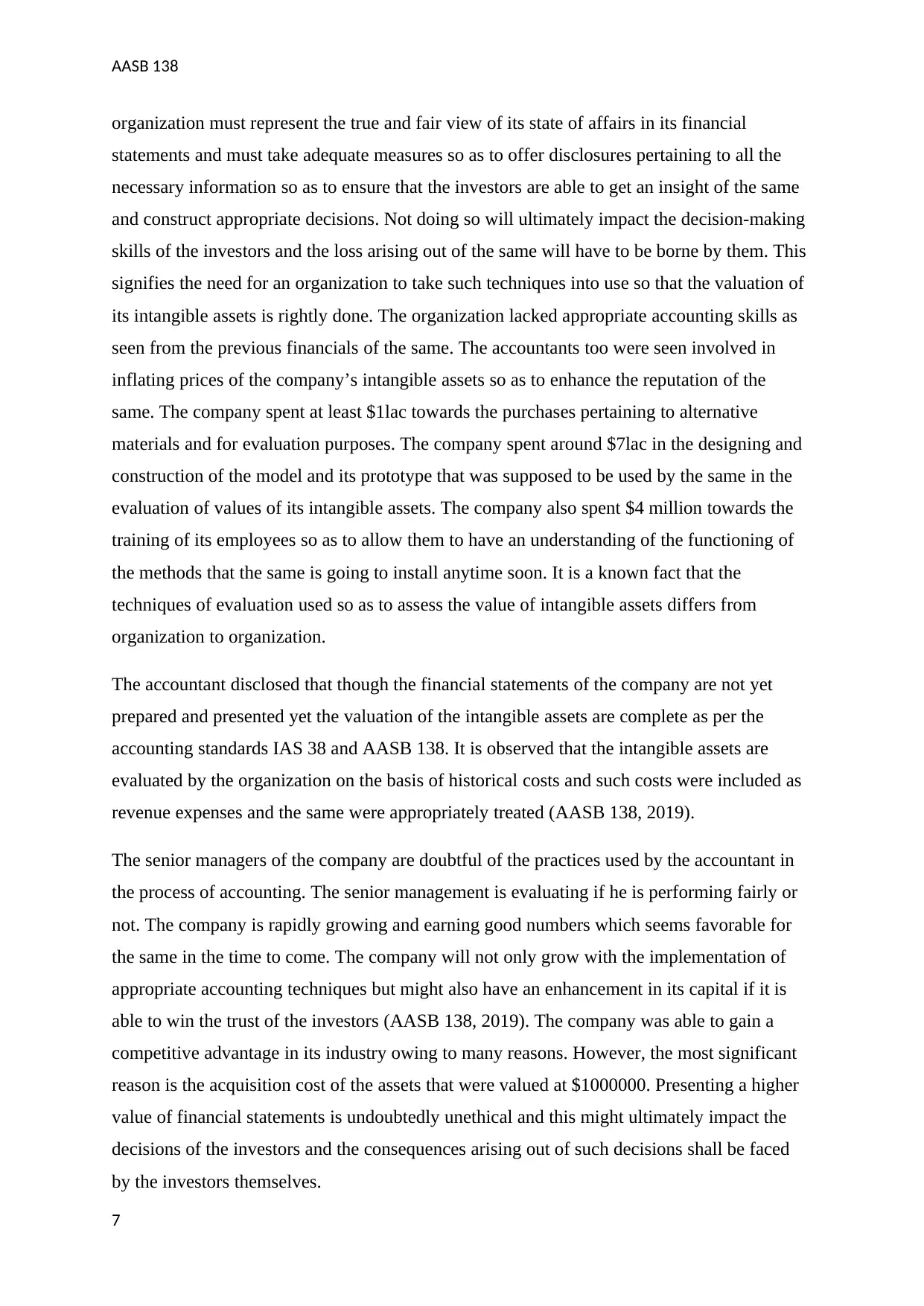
AASB 138
organization must represent the true and fair view of its state of affairs in its financial
statements and must take adequate measures so as to offer disclosures pertaining to all the
necessary information so as to ensure that the investors are able to get an insight of the same
and construct appropriate decisions. Not doing so will ultimately impact the decision-making
skills of the investors and the loss arising out of the same will have to be borne by them. This
signifies the need for an organization to take such techniques into use so that the valuation of
its intangible assets is rightly done. The organization lacked appropriate accounting skills as
seen from the previous financials of the same. The accountants too were seen involved in
inflating prices of the company’s intangible assets so as to enhance the reputation of the
same. The company spent at least $1lac towards the purchases pertaining to alternative
materials and for evaluation purposes. The company spent around $7lac in the designing and
construction of the model and its prototype that was supposed to be used by the same in the
evaluation of values of its intangible assets. The company also spent $4 million towards the
training of its employees so as to allow them to have an understanding of the functioning of
the methods that the same is going to install anytime soon. It is a known fact that the
techniques of evaluation used so as to assess the value of intangible assets differs from
organization to organization.
The accountant disclosed that though the financial statements of the company are not yet
prepared and presented yet the valuation of the intangible assets are complete as per the
accounting standards IAS 38 and AASB 138. It is observed that the intangible assets are
evaluated by the organization on the basis of historical costs and such costs were included as
revenue expenses and the same were appropriately treated (AASB 138, 2019).
The senior managers of the company are doubtful of the practices used by the accountant in
the process of accounting. The senior management is evaluating if he is performing fairly or
not. The company is rapidly growing and earning good numbers which seems favorable for
the same in the time to come. The company will not only grow with the implementation of
appropriate accounting techniques but might also have an enhancement in its capital if it is
able to win the trust of the investors (AASB 138, 2019). The company was able to gain a
competitive advantage in its industry owing to many reasons. However, the most significant
reason is the acquisition cost of the assets that were valued at $1000000. Presenting a higher
value of financial statements is undoubtedly unethical and this might ultimately impact the
decisions of the investors and the consequences arising out of such decisions shall be faced
by the investors themselves.
7
organization must represent the true and fair view of its state of affairs in its financial
statements and must take adequate measures so as to offer disclosures pertaining to all the
necessary information so as to ensure that the investors are able to get an insight of the same
and construct appropriate decisions. Not doing so will ultimately impact the decision-making
skills of the investors and the loss arising out of the same will have to be borne by them. This
signifies the need for an organization to take such techniques into use so that the valuation of
its intangible assets is rightly done. The organization lacked appropriate accounting skills as
seen from the previous financials of the same. The accountants too were seen involved in
inflating prices of the company’s intangible assets so as to enhance the reputation of the
same. The company spent at least $1lac towards the purchases pertaining to alternative
materials and for evaluation purposes. The company spent around $7lac in the designing and
construction of the model and its prototype that was supposed to be used by the same in the
evaluation of values of its intangible assets. The company also spent $4 million towards the
training of its employees so as to allow them to have an understanding of the functioning of
the methods that the same is going to install anytime soon. It is a known fact that the
techniques of evaluation used so as to assess the value of intangible assets differs from
organization to organization.
The accountant disclosed that though the financial statements of the company are not yet
prepared and presented yet the valuation of the intangible assets are complete as per the
accounting standards IAS 38 and AASB 138. It is observed that the intangible assets are
evaluated by the organization on the basis of historical costs and such costs were included as
revenue expenses and the same were appropriately treated (AASB 138, 2019).
The senior managers of the company are doubtful of the practices used by the accountant in
the process of accounting. The senior management is evaluating if he is performing fairly or
not. The company is rapidly growing and earning good numbers which seems favorable for
the same in the time to come. The company will not only grow with the implementation of
appropriate accounting techniques but might also have an enhancement in its capital if it is
able to win the trust of the investors (AASB 138, 2019). The company was able to gain a
competitive advantage in its industry owing to many reasons. However, the most significant
reason is the acquisition cost of the assets that were valued at $1000000. Presenting a higher
value of financial statements is undoubtedly unethical and this might ultimately impact the
decisions of the investors and the consequences arising out of such decisions shall be faced
by the investors themselves.
7
Paraphrase This Document
Need a fresh take? Get an instant paraphrase of this document with our AI Paraphraser

AASB 138
8
8
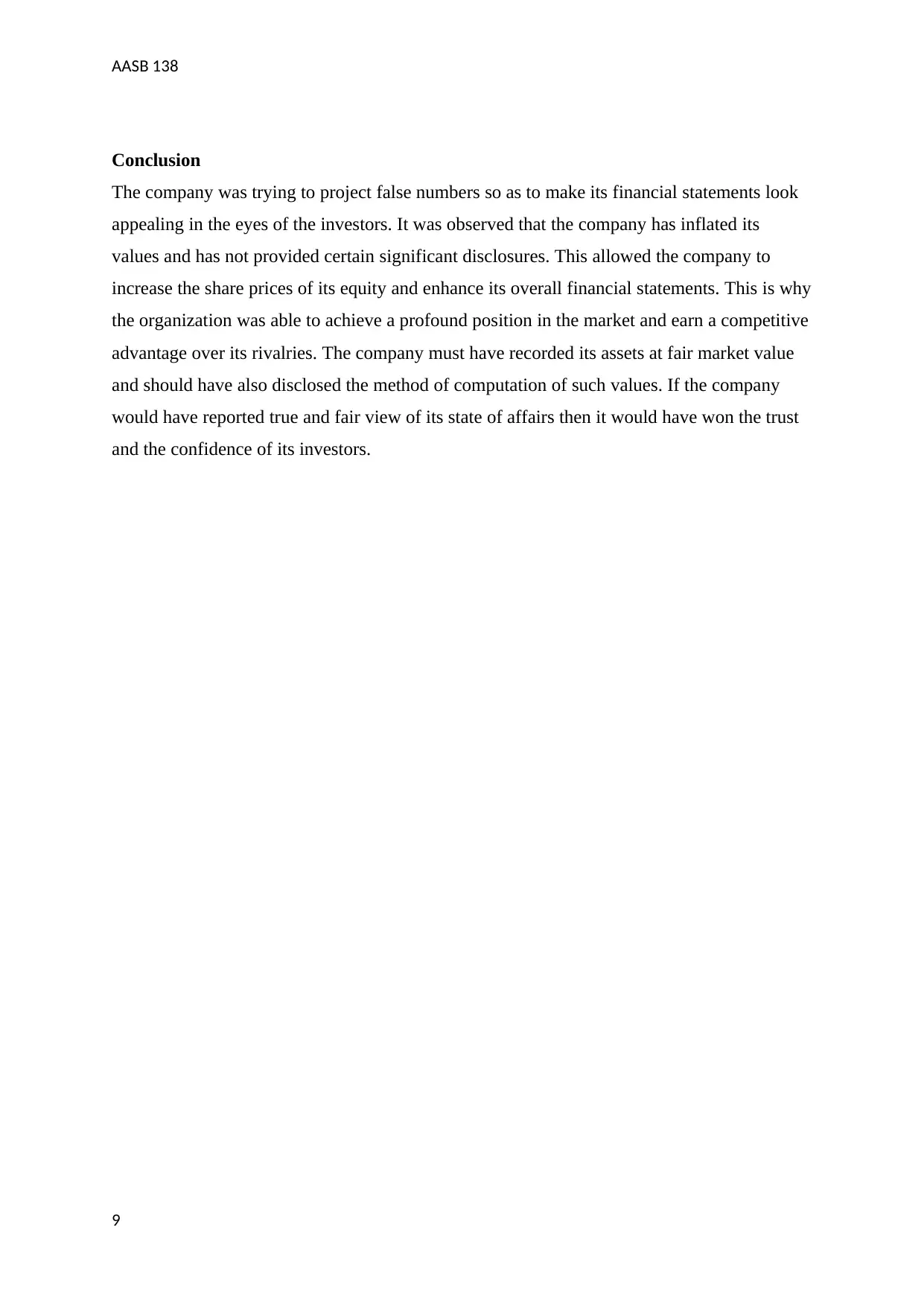
AASB 138
Conclusion
The company was trying to project false numbers so as to make its financial statements look
appealing in the eyes of the investors. It was observed that the company has inflated its
values and has not provided certain significant disclosures. This allowed the company to
increase the share prices of its equity and enhance its overall financial statements. This is why
the organization was able to achieve a profound position in the market and earn a competitive
advantage over its rivalries. The company must have recorded its assets at fair market value
and should have also disclosed the method of computation of such values. If the company
would have reported true and fair view of its state of affairs then it would have won the trust
and the confidence of its investors.
9
Conclusion
The company was trying to project false numbers so as to make its financial statements look
appealing in the eyes of the investors. It was observed that the company has inflated its
values and has not provided certain significant disclosures. This allowed the company to
increase the share prices of its equity and enhance its overall financial statements. This is why
the organization was able to achieve a profound position in the market and earn a competitive
advantage over its rivalries. The company must have recorded its assets at fair market value
and should have also disclosed the method of computation of such values. If the company
would have reported true and fair view of its state of affairs then it would have won the trust
and the confidence of its investors.
9
⊘ This is a preview!⊘
Do you want full access?
Subscribe today to unlock all pages.

Trusted by 1+ million students worldwide
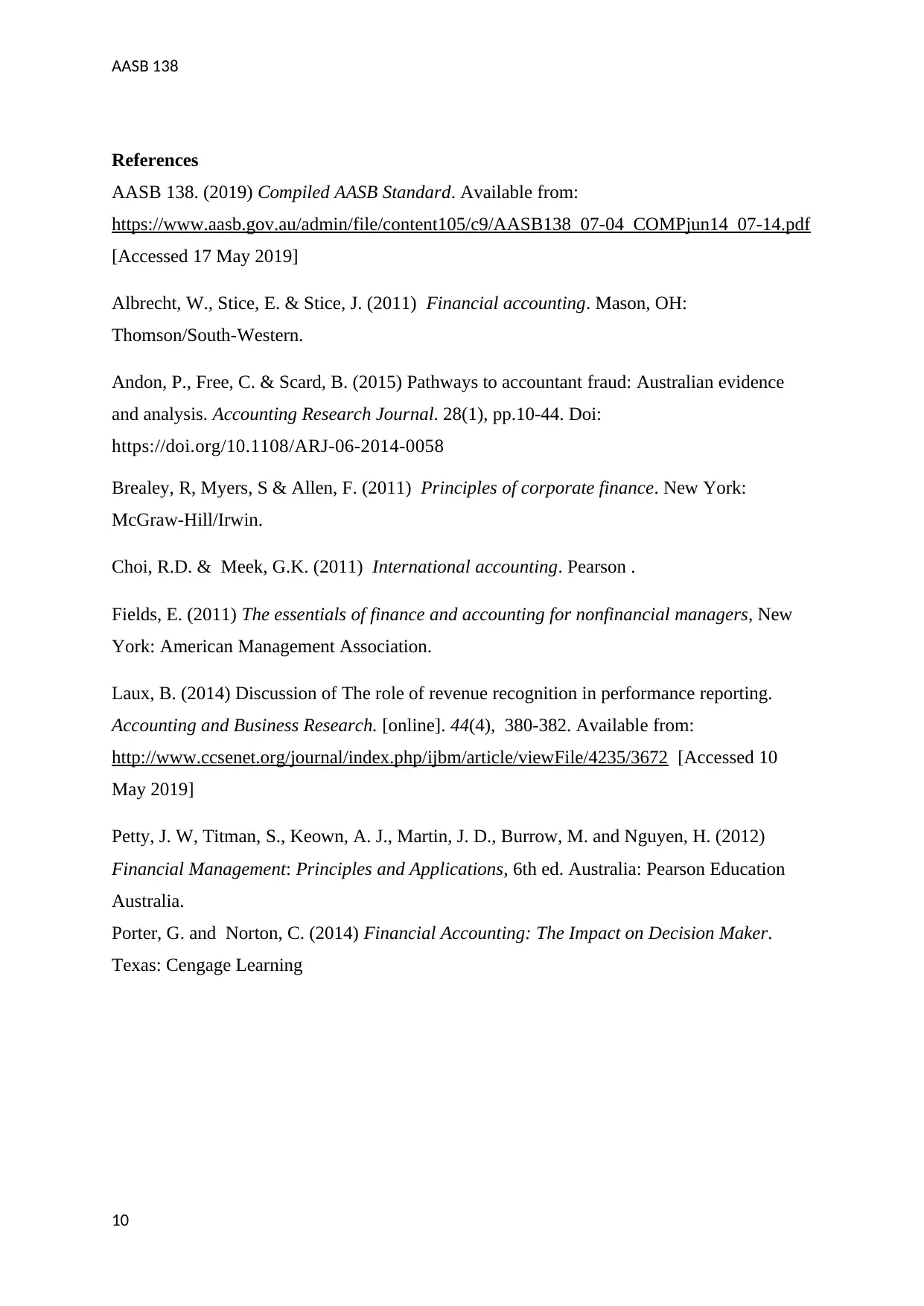
AASB 138
References
AASB 138. (2019) Compiled AASB Standard. Available from:
https://www.aasb.gov.au/admin/file/content105/c9/AASB138_07-04_COMPjun14_07-14.pdf
[Accessed 17 May 2019]
Albrecht, W., Stice, E. & Stice, J. (2011) Financial accounting. Mason, OH:
Thomson/South-Western.
Andon, P., Free, C. & Scard, B. (2015) Pathways to accountant fraud: Australian evidence
and analysis. Accounting Research Journal. 28(1), pp.10-44. Doi:
https://doi.org/10.1108/ARJ-06-2014-0058
Brealey, R, Myers, S & Allen, F. (2011) Principles of corporate finance. New York:
McGraw-Hill/Irwin.
Choi, R.D. & Meek, G.K. (2011) International accounting. Pearson .
Fields, E. (2011) The essentials of finance and accounting for nonfinancial managers, New
York: American Management Association.
Laux, B. (2014) Discussion of The role of revenue recognition in performance reporting.
Accounting and Business Research. [online]. 44(4), 380-382. Available from:
http://www.ccsenet.org/journal/index.php/ijbm/article/viewFile/4235/3672 [Accessed 10
May 2019]
Petty, J. W, Titman, S., Keown, A. J., Martin, J. D., Burrow, M. and Nguyen, H. (2012)
Financial Management: Principles and Applications, 6th ed. Australia: Pearson Education
Australia.
Porter, G. and Norton, C. (2014) Financial Accounting: The Impact on Decision Maker.
Texas: Cengage Learning
10
References
AASB 138. (2019) Compiled AASB Standard. Available from:
https://www.aasb.gov.au/admin/file/content105/c9/AASB138_07-04_COMPjun14_07-14.pdf
[Accessed 17 May 2019]
Albrecht, W., Stice, E. & Stice, J. (2011) Financial accounting. Mason, OH:
Thomson/South-Western.
Andon, P., Free, C. & Scard, B. (2015) Pathways to accountant fraud: Australian evidence
and analysis. Accounting Research Journal. 28(1), pp.10-44. Doi:
https://doi.org/10.1108/ARJ-06-2014-0058
Brealey, R, Myers, S & Allen, F. (2011) Principles of corporate finance. New York:
McGraw-Hill/Irwin.
Choi, R.D. & Meek, G.K. (2011) International accounting. Pearson .
Fields, E. (2011) The essentials of finance and accounting for nonfinancial managers, New
York: American Management Association.
Laux, B. (2014) Discussion of The role of revenue recognition in performance reporting.
Accounting and Business Research. [online]. 44(4), 380-382. Available from:
http://www.ccsenet.org/journal/index.php/ijbm/article/viewFile/4235/3672 [Accessed 10
May 2019]
Petty, J. W, Titman, S., Keown, A. J., Martin, J. D., Burrow, M. and Nguyen, H. (2012)
Financial Management: Principles and Applications, 6th ed. Australia: Pearson Education
Australia.
Porter, G. and Norton, C. (2014) Financial Accounting: The Impact on Decision Maker.
Texas: Cengage Learning
10
Paraphrase This Document
Need a fresh take? Get an instant paraphrase of this document with our AI Paraphraser

AASB 138
11
11
1 out of 11
Related Documents
Your All-in-One AI-Powered Toolkit for Academic Success.
+13062052269
info@desklib.com
Available 24*7 on WhatsApp / Email
![[object Object]](/_next/static/media/star-bottom.7253800d.svg)
Unlock your academic potential
© 2024 | Zucol Services PVT LTD | All rights reserved.





